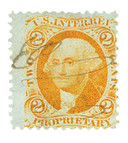1862-71 Proprietary Stamp – Old Paper
The Revenue Act of 1862 established new taxes on many everyday items and called for specific stamps for each taxable item. Butler and Carpenter of Philadelphia was awarded the printing contract scarely two months before the law was to go into effect.
As war raged and resources stretched thin, the firm was al... more
1862-71 Proprietary Stamp – Old Paper
The Revenue Act of 1862 established new taxes on many everyday items and called for specific stamps for each taxable item. Butler and Carpenter of Philadelphia was awarded the printing contract scarely two months before the law was to go into effect.
As war raged and resources stretched thin, the firm was allowed to ship the stamps whether or not the perforating process was complete. Therefore the First Issue Revenue stamps may be found perforated horizontally and vertically, imperforate, or partially perforated. “Part perforated” stamps were created unintentionally. Because revenue was needed quickly to finance the war, the stamps were pulled from production before they were completed. As a result, they feature perforations in one direction only and resemble coil stamps.
Each First Issue Revenue stamp features the same portrait of George Washington, which is based on a work by Gilbert Stuart. However, the various taxable categories and denominations differ in the design of the lathwork frame that surrounds the Washington portrait. The tax was later repealed on some articles.
Between 1862 and 1869, Butler and Carpenter printed Revenue stamps on “old paper.” A catch-all phrase, “old paper” is actually a number of different papers that share certain characteristics: they’re grayish-white, thin, unwatermarked, and brittle. These traits were intentionally chosen as they allowed the paper to hold ink well. “Old paper” was in use until 1869.
U.S. Revenue Stamps –
Expand Your Collection or Start a New One
Intricate Revenue stamps feature the rich detail and
historical importance of classic U.S. stamps for a fraction of the price. When the Civil War erupted in 1861, the country was on the verge of bankruptcy. A plan was developed to generate internal revenue – money collected from taxes placed on domestic items such as tobacco, alcohol, medicine, perfume and playing cards. Stamps were provided as proof of payment. Examining used U.S. Revenue stamps offers a window into the past – the government required several unusual cancellation techniques such as private cancels, manuscript initials and perforated initials. The same legislation that created these stamps also created the Internal Revenue Service (IRS) and the Bureau of Engraving and Printing (BEP). Until 1862, specific Revenue stamps were required for many taxable items – leading to a wealth of interesting stamps for modern collectors. Imperforate and “part-perf” stamps present another challenging – yet affordable – collecting opportunity.
Less 










